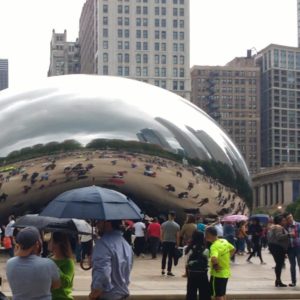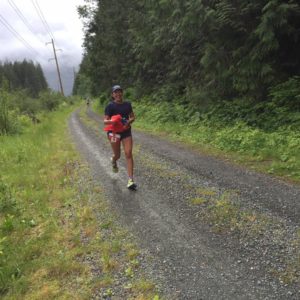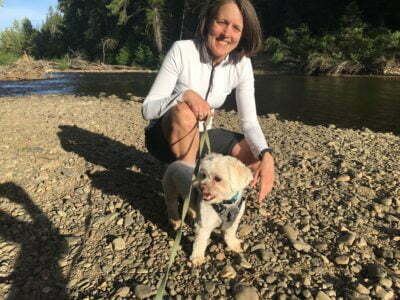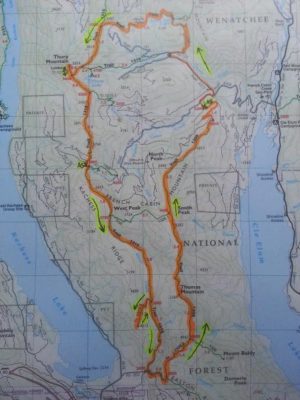Squamish 50 mile and 50k are difficult courses across the board, run on technical singletrack trails. The 50M starts relatively flat for the first 6 miles and then the final mile, but has lots of climbing in between, with the largest climb being roughly 2500 feet. The 50k course is nearly as difficult, also having flatter sections on the front and back end, but the main climb is near the beginning of the race, as it’s the last 50k of the 50M course, and so is a point to point race, whereas the 50M is a loop. Then there are the brave souls who run the 50/50, 50M on Saturday, 50k on Sunday. New for 2018 is a 23km race on Sunday.
Race Details
50m Detailed Course Description
50k Detailed Course Description
Lessons Learned from Race Reports
- No poles allowed
- All 50M runners must start with a headlamp, which you can drop at Aid Station 2 to be transported by the race staff to Aid Station 7
- Since the 50k is a point to point course, not a loop like the 50M, have your transportation sorted out to the start; there is a race bus that can take you there.
- Very difficult courses, so you need just as much of a strong mental game as a physical one
- Exposed sections – wear sunscreen and a hat!
- Lots of super technical, non-runnable trails
- Likely to to be hot, having a neck cooler or a buff to help keep you cool on the climbs
- With how slow the course is, accept that you’ll likely need a headlamp the second time in the evening for the 50M
- Hard to find a flow in the race because the lack of runnability of so much of the course
- The terrain makes the course more challenging than the elevation gain
- Last 10k of the course is very challenging and easy to have a very low point physically and mentally
- Be sure to carry enough fueling given the slow course and mileage between aid stations
- Use the course preview runs if you have the chance
- If you’re in Seattle, trails for good race simulation are Tiger and Rattlesnake for good climbing and power hiking, Poo Poo Point for technical descending, and Shangri La Trail for running faster on both ups and downs
- Aid Station #1, Canadian Tire, tends to be very crowded for crew, as they are all heading there at the same time and may experience parking delays, so don’t rely too heavily on your crew here
- Practice technical descents as much as possible
- Lots of people leave the last aid station (Farside) at mile 43 pushing hard to the finish, and even though there is only “one more climb” up Phlem, there are still climbs on the way to Phlem
- See Matt K’s race report on the 50/50 for details about the course, the aid, his lessons learned, and what he’d do differently for training to prepare for those hairy, technical descents.
Elevation
Total gain/loss:
50M: 11000/11000
50k: 8500/9000
Total climbs:
50M: 1×2555, 1×1400, 1×900, 1×400, 4×200-400 feet
50k: 1×2600, 1×1400, 3×200-400 feet
Longest climb:
50M: 2555 feet in 6.5 miles from mile 20.7-27.2
50k: 2600 feet in 9.4 miles from mile 0.0-9.4
Steepest climb:
50M: 1223 in 1.7 miles from mile 8.4-10.1 (13.6% grade)
50k: 2037 in 3.3 miles from mile 5.9-9.2 (11.7%grade)
Elevation profile:
50M: http://squamish50.com/wp-content/uploads/2014/11/Squamish50M-1.jpg
50k: http://squamish50.com/wp-content/uploads/2014/11/Squamish50K.jpg
Aid stations
Total aid stations: (50M) 8, (50k) 5
Furthest distance apart: (50M) 7 miles, (50k) 6.2 miles
Locations:
50M: Mile 6 / 12 / 17 / 23 / 30 / 33 / 38 / 43
50k: Mile 5 / 11 / 14 / 20 / 25
What’s available: Mix of Hammergel and Heed electrolyte drink mix, fruits such as oranges, bananas, watermelon, chips, both potato and gluten-free, snacks such as salted pretzels, gummies, cookies, salted potatoes, etc., water and Coke, other gluten-free options
Crew access
50M: Able to crew at AS #1, #2, #5 and #7 (miles 6, 12, 30, and 38)
50k: Able to crew at AS #3 and #5 (miles 14 and 25)
Crew Driving Directions:
50 Mile Start at Squamish Oceanfront to Aid Station #1 at Escape Route
Aid Station #1 at Escape Route to Aid Station #2 at Alice Lake
Aid Station #2 at Alice Lake to Aid Station #5 at Quest
Aid Station #5 at Quest to Aid Station #7 at Far Side
Aid Station #7 at Far Side to Finish Line in downtown Squamish
Pacers
None allowed
Race qualifiers
UTMB – 50M: 4 points, 50k: 3 points, 23k: 1 point
Race reports
50M:
Mark Cliggett’s 2018 50/50 Race Report
Mark Cliggett’s 2018 50/50 Race Report (more detailed)
Matt K’s 2017 50/50 Race report
http://gingerrunner.com/2013/08/27/race-recap-the-squamish-50-miler/ (Check out the likes and dislikes at the bottom of his race report for a summary)
https://krisandnotsodeepthoughts.wordpress.com/2016/08/23/squamish-50-race-report/
50k:
http://jeffpelletier.com/squamish-50k-2014-race-report/
Strava activities and GPX files
50M:
https://www.strava.com/activities/375335917/overview
https://www.strava.com/activities/185426409
50k:
https://www.strava.com/activities/376837387
https://www.strava.com/activities/684412091/overview
Race Website
http://squamish50.com/
































